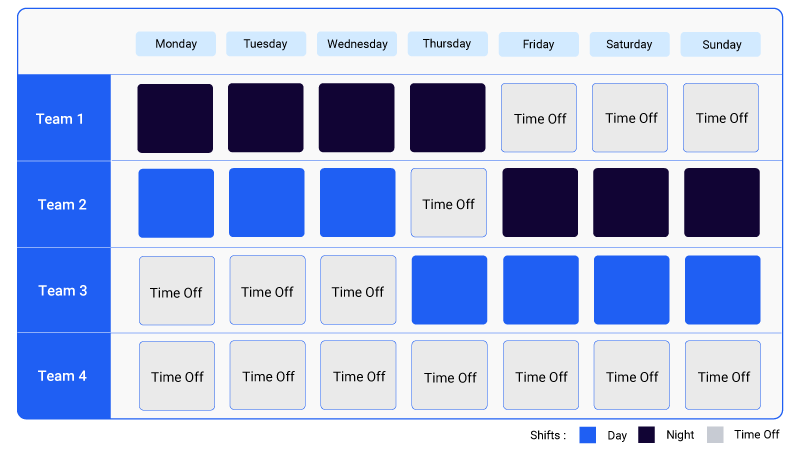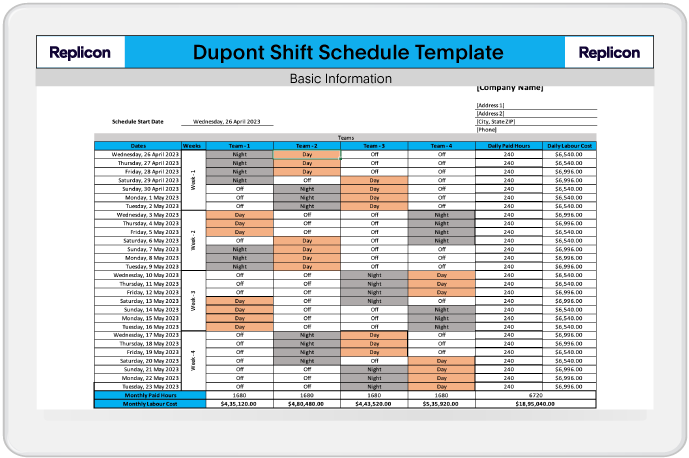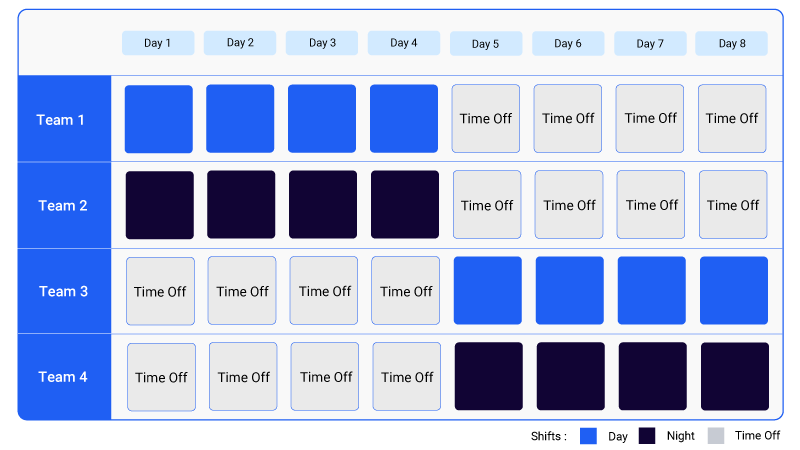What Is a Dupont Shift Schedule and How to Implement It? (Free Template)

The traditional 9 am to 5 pm schedule works well for most businesses, but some industries, such as manufacturing, airlines, and healthcare, require around-the-clock operations.
So, what’s the best schedule that can provide 24-hour coverage while ensuring better work-life balance for employees?
It’s the DuPont shift schedule – an excellent way to organize work hours to provide 24/7 services.
This blog will uncover how the DuPont shift schedule works, its advantages & disadvantages, industries that use it, and tips to help you implement it with the least effort.
What Is the DuPont Shift Schedule?
DuPont shift schedule is a pattern in which four teams rotate between day and night shifts in a 4-week cycle to provide 24-hour shift coverage. Each team does a 12-hour shift and works an equal number of day and night shifts during the 28-day cycle.
|
Simply put, DuPont is a shift pattern that:
|
The four-week cycle of DuPont is split into four stages, and each team has to go through all the stages to complete one rotation.
|
All the teams have to go through each stage one by one; however, not all the teams start their rotation from Stage 1.
For instance, if Team 2 starts from Stage 2, then Team 3 will start from Stage 3 and so on. But, all the teams will eventually progress through each stage before the cycle ends.
Here’s the demonstrative representation of DuPont schedule for your better comprehension:

|
Did you know? This schedule was named after the American multinational chemical company DuPont, which invented and first used this work pattern in 1950. |
DuPont Shift Example
Let’s have a closer look at how the first week in the DuPont schedule looks like when all teams work together-

- Team-1 starts from Stage 1: They work a four night shift, followed by three consecutive days off.
- Team-2 starts from Stage 2: They work three day shifts, have a day off, then do 3-night shifts.
- Team-3 starts from Stage 3: At the start of the week, they’ll have three days off and then work four day shifts.
- Team-4 starts from Stage 4: This team will have an entire week off, i.e., they’ll be on time off for all seven days of this week.
Note: Each team follows its own four-week schedule to provide 24/7 coverage, with any two teams working at all times.
The DuPont shift schedule comprises a total of 14 shifts of 12 hours (including day and night) in one rotation cycle (28 days), so each team works for a total of 168 hours per cycle. On an average, each team works 42 hours per week. However, during the weeks that have six workdays, teams have to work 72 hours a week.
Does the DuPont Shift Schedule Allow For Overtime?
In the DuPont schedule, teams work 42-hr per week on an average. However, each week has different work hours; thus, the overtime hours for each week also vary accordingly.
- In the first week, the team does four 12-hr shifts, adding to a total 48-hour workweek. Thus, an overtime of 8 hours is applicable for this week. So, the employer will have to provide regular pay for the 40 hours and overtime pay for 8 hours.
| Regular Hours | Overtime Hours | Total Work Hours |
|---|---|---|
| 40 | 8 | 48 |
- In the second week, a total of six 12-hour shifts are worked by each team, which adds to a total of 72 hours of the workweek. Thus, an overtime of 32 hours is applicable in the second week. So, the employer will have to provide regular pay for the first 40 hours and overtime pay for the remaining 32 hours.
| Regular Hours | Overtime Hours | Total Work Hours |
|---|---|---|
| 40 | 32 | 72 |
- In the third week, the team works four 12-hr shifts, equaling 48 work hours. Thus, again, the overtime of eight hours is applicable. So, the employer will have to provide regular pay for the first 40 hours and overtime pay for the rest of the 8 hours.
| Regular Hours | Overtime Hours | Total Work Hours |
|---|---|---|
| 40 | 8 | 48 |
- There are no work days in the fourth week, so no overtime is applicable.
| Regular Hours | Overtime Hours | Total Work Hours |
|---|---|---|
| 0 | 0 | 0 |
Here’s a look at the entire cycle and its overtime hours:
| Week | Regular Hours | Overtime Hours | Total Work Hours |
|---|---|---|---|
| 1 | 40 | 8 | 48 |
| 2 | 40 | 32 | 72 |
| 3 | 40 | 8 | 48 |
| 4 | 0 | 0 | 0 |
The overtime law can differ from one state to another. That’s why it’s necessary to check a state’s overtime law to stay compliant with local labor laws.
For instance, in California, the employer must pay overtime at the rate of one and a half times the employee’s regular pay rate for all hours worked in excess of eight hours. On the other hand, the hours worked in excess of 12 hours a day are paid at double the regular pay.
|
Staying compliant with the local labor laws is necessary to avoid any legal problems. But keeping a tab on employee’s overtime hours and calculating the payroll accordingly is cumbersome. Replicon’s time tracking software simplifies calculation of employees’ payroll as per the hours worked and also helps comply with the local labor laws. Sign up for a Free Trial now! |
Advantages and Disadvantages of DuPont Schedule
Advantages of DuPont Schedule
Around-the-Clock Services
DuPont schedule allows businesses to operate around the clock so that they can generate higher revenue by serving more customers. Keeping the services open 24/7 can also help them attract customers from different countries and time zones. This way, they can expand their businesses into the global market.

Uniform Distribution of Night Shifts
When an employer distributes the night shifts unequally, it increases the likelihood of employee dissatisfaction and conflicts. However, this rotating schedule equally distributes the night shifts among all teams, i.e., each team gets an equal number of night shifts.
Consecutive Seven Days Off
One of the greatest advantages of this schedule is that employees get one entire week off every cycle. Employees can use this weeklong off for their personal commitments, such as spending time with family, pursuing hobbies, planning a mini-vacation, etc.
Seven days off in a row allows them plenty of time to relax and recharge, thus preventing the chances of burnout and fatigue.
Greater Customer Satisfaction
Today, people want to have the facility to get services or products whenever they want, irrespective of the time and location.
This is where the DuPont schedule comes into the picture, allowing businesses to keep their services open 24/7, which ensures that someone is always available to attend to the customers.
Maximum Days Off Than Any Other Schedule
A standard work schedule provides around eight days off, whereas DuPont rewards employees with 15 days off per 28-day cycle that they can use to do anything they like.
Having more time offs ensures better work-life balance and increased employee satisfaction.
Reduction in Commuting Time
Compared to other schedules, this shift pattern has fewer workdays, which reduces commuting frequency. This way, the DuPont rotating schedule helps employees save their time, energy, and fuel.
Moreover, the shifts of employees are longer and operate at different times than the conventional schedules; thus, employees can easily avoid the rush hours and reach the office and home in less time.
Improvement in Productivity
In the DuPont shift schedule, employees do 12-hour shifts daily. The longer work hours allow employees to have uninterrupted work periods to focus on their tasks and complete them without any distractions.
Extended work hours allow them to plan their day effectively so that they can focus on each task at a time without the need to transition between multiple tasks frequently.
Disadvantages of DuPont Schedule
Challenging Shift Coverage
If an employee needs time off for some reason, finding a replacement for their shift is very difficult. For example, if a person who covered the night shift the previous day is asked to cover the day shift for the next day, it may overwhelm them.
Adjustment Issues
Though this shift has a predictable timetable, the schedule of all four weeks differs from one another. Thus, workers may find it hard to adjust to this schedule due to its forward and backward rotations. The shift can disturb their lifestyle and sleep cycle and make it challenging to fulfill family duties.
In fact, due to the unconventional work hours, shift workers are left with limited time to interact with their family and friends, thus impacting their relationships and emotional well-being.
Not Applicable for All Industries
This schedule works best for industries, such as call centers and healthcare, that have to deal with customers’ requests around the clock.
But, it’s not suitable for industries requiring excessive physical work, as it can be too tiring for employees to work 12 hour shifts. In addition, industries that require creative or cognitive thinking also don’t fit well with this schedule.
Risk of Injuries Due to Fatigue and Exhaustion
Working a 12-hour shift can be quite tiring for employees and can increase the chances of fatigue and burnout.
In addition, long work hours can impact cognitive functioning, decrease concentration and increase the chances of human errors that can result in workplace injuries.
Poor Impact on Health
Rotational shifts have always been linked with poor eating habits and disrupted sleep patterns.
In fact, as per medical studies, shift workers are more susceptible to sleep disorders, obesity, gastrointestinal issues, and cardiovascular diseases.
Plus, the DuPont schedule has both forward and backward rotations that can worsen the situation. Though a forward rotation (day to night shifts) minimizes disruptions to sleep cycles, a backward rotation (night to day shift) negatively impacts the sleep cycle. That’s why it’s said that forward rotation is better than backward rotation for most people.

Productivity Issues Due to 72-Hour Workweek
In the second stage of the DuPont Schedule, employees need to work a total of six 12-hr shifts, which equals a 72-hour workweek. Working 72 hours in a single week can take a toll on their mental and physical health. This means they won’t be able to contribute properly to work.
Due to the 72 work hours every three weeks, this shift pattern has more risk of overworked and stressed employees.
Also, as per a study from inc.com, an average worker is productive for two hours and 53 minutes in an eight-hour workday.
So, keeping the above stat in mind, if employees are doing a 12-hr shift, it doesn’t necessarily mean that all of them work productively for 12 hours, especially if their work involves logical or creative thinking.

Difficulty in Scheduling the Shifts
Manually planning the shifts can be cumbersome as it requires meticulous planning and thorough analysis while having some room for backup. The schedule requires four teams that rotate on different days in the day and night shifts, and a single error in scheduling can impact the cycle of others as well.
Especially when employees are provided with the liberty to swap shifts, then the situation is likely to aggravate more.
In the presence of these factors, it’s important to plan this schedule in a way to minimize the risk factors. The next section talks all about the ways this can be made possible.
How to Implement the DuPont Shift Schedule
Determine an Appropriate Team Size
Implementing the DuPont schedule requires four teams to operate; however, the number of resources in each team can vary depending on the job involved or the industry type. It’s necessary to determine an appropriate team size so that it doesn’t result in any skill gap or social loafing.
In the DuPont schedule, finding a replacement for a person who’s on leave is another challenge. Thus, make sure to have an appropriate team size so that the workflow doesn’t get impacted even if a team member is on time off and you can’t find any replacement for them.
Help Employees Adjust to This Shift
When this schedule is implemented, employees may have difficulty getting used to this shift.
This schedule includes both forward and backward rotation, so employees may find it hard to cope with the sudden shift changes for the initial days.
For example, if employees who recently worked three night shifts have to work a day shift, then acclimating to the day shift can be challenging for them. In addition, they’re more prone to make mistakes due to a disrupted sleep pattern.
That’s why employers and managers should regularly check on how employees are doing and help them ease into this transition phase by paying attention to the office environment, work culture, and individual well-being.
Here are a few tips for managers to help the employees adjust to a new shift:
- Make sure the office has access to sufficient lighting (daylight and artificial light) and ventilation.
- Ensure that employees are provided with rest areas or sleeping rooms to rest for some time to mitigate the effect of extended working hours.
- Educate employees about the significance of healthy nutrition, proper sleep, and self-care from time to time.
- Managers can consider soliciting feedback from employees to check any area of improvement and work on it.
Check the Workload Distribution
DuPont is known for its fair and equal shift distribution, but it’s the manager’s responsibility that the workload distribution should also be just. They should avoid a scenario where a team keeps slacking off its work, and the other team has to pick up the slack.
Make sure all teams are pulling their weights equally and no single team is getting all the workload.
Tip: If you think that the workload can be more during the day shift than the night shift, you can consider varying the team sizes for day and night times.
Encourage Employees to Take Adequate Breaks
Unlike general shifts, the 12-hr shifts can be exhausting for employees and decrease their productivity. Thus, employees must take adequate breaks during their shifts to stay productive and refreshed.
As a manager, you should encourage team members to take sufficient breaks whenever they need them.
Everyone has different preferences for break timings and intervals; for example, some employees may take breaks every half an hour, while others would like to take a break after 90 minutes of deep focus work. To better manage the break intervals, you can consider setting a minimum and maximum limit for taking breaks.

Have a Proper Communication System
Effective communication and collaboration are keys to the successful implementation of any schedule.
Once you’ve implemented the schedule, consider checking with employees regularly regarding how they are doing or if they’re facing any challenges. Especially people with family obligations can have a hard time adjusting to this shift, so you can ask them if there’s any issue and whether you can help them in any way.
An open line of communication will give a sense of feeling to your teams that you are thoughtful towards them.
You can also create a system in which team members can swap their shifts with each other with proper communication.
For example, some of your employees may prefer day shifts more, while others find night shifts more convenient. There should be a system where they can swap their shifts after proper communication while keeping their respective managers informed.
Create the Schedule in Advance
It’s a good practice to create the schedule in advance and share it with teams so they can organize their errands and plan things beforehand.
For instance, if you inform the employees about their next month’s shift in advance, they can check when they have time off and can plan any short trips or book their necessary appointments. Sharing the schedule with your employees in advance will improve their morale as it makes them feel included in the shift-setting process and increases job satisfaction.
|
Need help with scheduling employees for several types of shifts? Try Replicon’s Workforce Management solution to schedule resources on the shifts you need and keep track of each employee’s schedule. Try a Free Demo now! |

Dupont Shift Schedule Template (Free Download)

Which Industries Use the DuPont Shift Schedule?
Industries that require operation 24/7 or want to entertain customers’ requests around the clock find this schedule most suitable. However, to implement this schedule, it’s necessary that the businesses have enough resources to split them into four groups who can work 12-hr rotational shifts.
|
Businesses that find the DuPont Shift most beneficial:
|
Should You Use the DuPont Schedule?
DuPont schedule is popular among industries that require 24/7 operation. But, before implementing this schedule in your organization, consider the following points:
- Evaluate if your business needs a 24-hour operation.
- Talk to your employees and ask if they’re willing to work these rotating 12 hour shifts.
- Assess the potential risks that employees may face, such as burnout, fatigue, exhaustion, and low productivity.
- The shift pattern involves around 48 hours of overtime, for which you may have to pay at the rate determined by local labor law. Evaluate if the payroll matches or exceeds your budget.
- Do you have sufficient resources to split into four groups and a sophisticated system to provide backup when some team members are on time off?
Apart from several advantages, this schedule has certain disadvantages as well, as discussed above. So, before making a decision, evaluate all the pros and cons of this schedule and how it can benefit your businesses. To better understand its suitability, you can first take a trial by implementing one cycle of this schedule in one department and assessing how it goes.
Are There Other Schedules Available for 24-Hour Shift Coverage?
Apart from the DuPont schedule, a few other schedules also provide 24-hour coverage with 12-hr shifts. So, if the DuPont work schedule doesn’t suit your requirements, you can try these alternatives.
Pitman Schedule
- Number of teams: Four
- Shift duration: 12 hours
- Rotation period: 14 days or 2 weeks
- Week 1: Employees work two shifts, have two days off, and then work three more shifts.
- Week 2: They get two days off, work two shifts, and get three days off again.

Panama Schedule (or 2-2-3 Schedule)
- Number of teams: Four
- Shift duration: 12 hours
- Rotation period: 28-day cycle
- Week 1: Each team works for two days, gets two days off, and then works for three days.
- Week 2: The same team gets two days off, then works for two days and then again gets three days off.
On a fortnightly basis, these teams swap their day shifts with the night shifts and vice versa. For example if a team is working the day shift during Week 1 & 2 of the cycle, it’ll pick the night shift for the next two weeks.

|
To understand this work pattern in detail, check out our blog on the 2-2-3 Work Schedule. |
Four On, Four Off
- Number of teams: Four
- Shift duration: 12 hours
- Rotation period: 16 weeks
Each team works four consecutive days and gets four days off. In this pattern, two teams work at a time while the other two are on time off.

DDNNOO
- Number of teams: Three
- Shift duration: 12 hours
- Rotation period: 6 days
In this schedule, each team does two day shifts, two night shifts and gets two days off.

|
|
Bottom Line
DuPont schedule helps businesses serve their customers around the clock and get more profitability. Additionally, this shift provides maximum time offs than any other schedule, which helps employees charge their batteries and maintain their work-life balance.
If you plan to implement this schedule, it’s necessary to ask employees if they’re ready to work this shift. Also, you should help employees ease this transition and check their well-being and productivity from time to time. Most importantly, have a proper system to ensure you follow the pay rules and manage the resources for this schedule with clarity, minus any planning hiccups to make the most of it.






